| Article ID | Journal | Published Year | Pages | File Type |
|---|---|---|---|---|
| 6298135 | Biological Conservation | 2016 | 11 Pages |
Abstract
Many remaining wild tiger populations persist in small numbers at sites where densities are less than half of their estimated carrying capacity and will continue to decline if not protected from poaching. Although law enforcement is frequently used to protect tigers and their prey, the conditions under which enforcement is likely to be effective in recovering small populations of wild tigers are not well understood. We evaluated the effectiveness of a law enforcement strategy to recover tigers and their prey in Lao PDR where extensive habitat provided favorable conditions for large increases in tiger numbers if protected from poaching. Over a seven-year period, we monitored along a theory of change to evaluate assumptions about the causal linkages between intermediate results and biological outcomes. Although we found a strong positive correlation between funding for enforcement and days patrolled (rs = 0.786, n = 7, p = 0.05) and a significant negative correlation between days patrolled and overall hunting catch per unit effort (rs = â 0.893,n = 7, p < 0.05), ultimately a proliferation in snaring was associated with decline in several indices of tiger abundance. We conclude that actions were sufficient to reduce poaching and increase prey populations, but insufficient to curtail extirpation of tigers. Recovering small populations of high-value wildlife such as tigers in promising source sites is dependent on establishing a complete enforcement regime, complimentary strategies that build support for the enforcement regime, and a nimble monitoring and evaluation system for agile adaptive management.
Keywords
Related Topics
Life Sciences
Agricultural and Biological Sciences
Ecology, Evolution, Behavior and Systematics
Authors
Arlyne Johnson, John Goodrich, Troy Hansel, Akchousahn Rasphone, Santi Saypanya, Chanthavy Vongkhamheng, Venevongphet Venevongphet, Samantha Strindberg,
